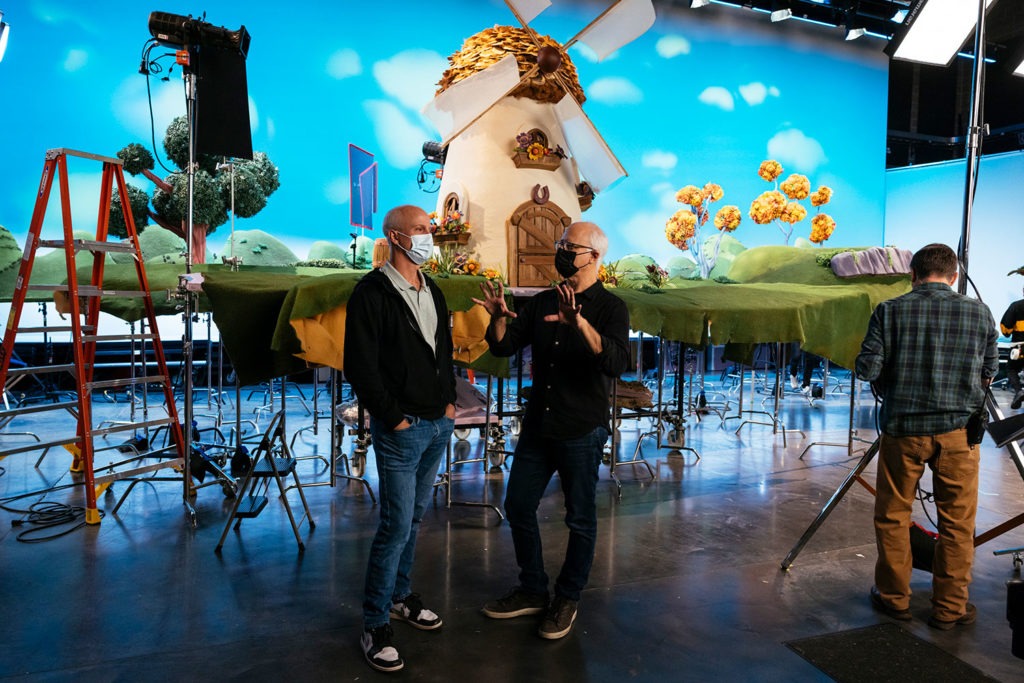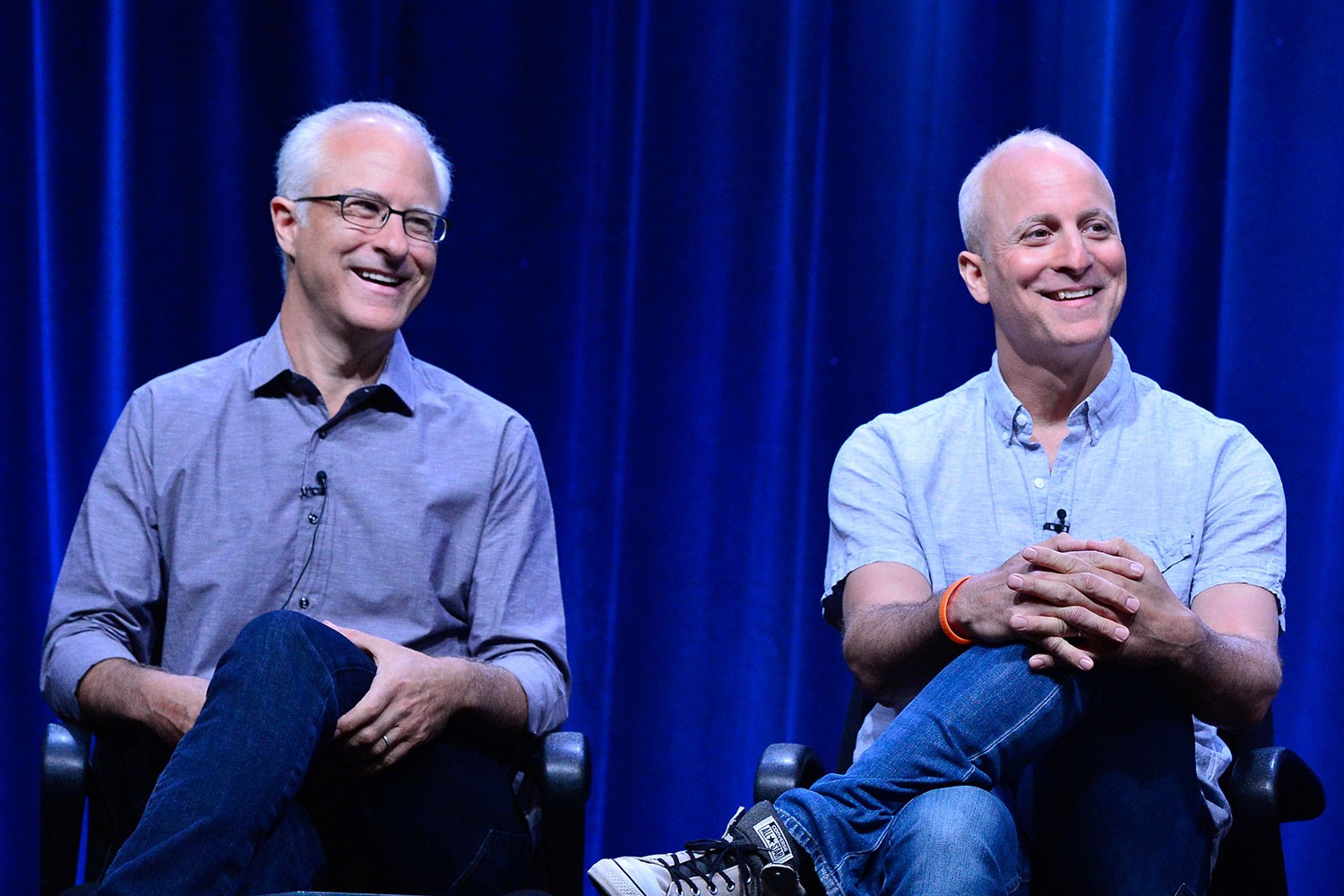You might not know David and Adam Rudman’s names, but you probably know their work. For more than 35 years, David Rudman has been a Muppet performer, and he currently voices Cookie Monster, Baby Bear, Beaker, Scooter, Janice, and the right head of the Two-Headed Monster. His brother Adam cut his teeth writing for Sesame Street, too. But almost 20 years ago, the pair also decided to strike out on their own, launching Spiffy Pictures out of Highland Park.
Today, Spiffy has five full-time staffers working to craft shows like PBS Kids’ Donkey Hodie and Nature Cat, though that number can balloon to about 40 when those shows are in production. Like Bob “Bozo” Bell and Ray Rayner before them, the Rudmans are fully committed to making quality children’s television out of Chicago: Their shows are educational and smart, while still a bit wacky and askew. Chicago magazine talked to the Rudmans about their television origins, digging through Fred Rogers’ archives, and why we’re all a little bit like Grover.
How did you two first fall in love with children’s television?
David: For me it was just falling in love with television, and not necessarily children’s television. Growing up, we used to watch television and always try to figure out how they made the shows, both for live action and for animated shows. I was always thinking, “How did they make that?” Specifically, though, when I saw the Muppets, that sort of blew my mind as a kid. I was like, “How are those things coming to life on TV?”
Adam: For me, it was simpler. The first things I watched were cartoons and I just fell in love with seeing something that can make me laugh. I could watch and laugh and enjoy whatever, and I’d start to care about these characters, whether it was Bugs Bunny or Droopy Dog or some live action thing like Little Rascals. I always was drawn to storytelling and humor, and the idea that I could bring it to an audience of young fans.
We’re coming up on 20 years of Spiffy. What made you guys want to put out your own shingle in the first place?
David: We always loved television and film, and growing up we were always making videos and entertaining family. Creating your own shows is something that we had always wanted to do since we were little, so once I learned how to make television and what goes into it and got a lot of experience in the medium, I wanted to make my own shows even more. I wanted to put my own stamp and my own vision out there. We wanted our shows to look different than other shows and to have a sly sense of humor. That wasn’t really out there as much.
How would you describe the Spiffy aesthetic? If we were to look at one of your shows, how would we know you made it?
Adam: Our stamp is definitely unique original characters and great humor, whether it’s physical comedy or it’s humor from the story.
David: Music, too. We always incorporate music into our shows.

Are there characters that you did growing up that really stuck with you?
David: Like Adam said, we grew up with The Little Rascals and Looney Tunes. Three Stooges, Jack Benny, The Beatles… those are our influences.
If you look at our shows, all of our influences are sprinkled in, like you’ll see a little Mad Magazine or some of the shows we grew up watching and reading. It’s in all our shows, but in 2005 we created Jack’s Big Music Show for Nick Jr., and that was inspired by the Jack Benny show. Well, really, it was a mash up between Jack Benny and The Beatles, in a way that if you’re a fan of either of those things, you’ll see all references sprinkled throughout.
Another of our shows, Bunnytown, is almost like a love letter to 1970s variety shows, but with a little Mad magazine sprinkled in.
Adam: Nature Cat is just Looney Tunes. It’s Bugs Bunny, but with a nature curriculum. All our shows are inspired by these different shows or genres, but we’re putting our spin on them.
When people think of where TV is made, they often think of places like LA and New York. You’ve both worked outside Chicago, but you made a point of coming back. What made you commit to the Windy City?
Adam: Well, we’re from here, but there’s also such a rich history of children’s shows here in Chicago that we watched growing up, from Ray Rayner to Garfield Goose.
It’s also because there are so many talented people here in Chicago and they’ve been with us for a really long time with all of our shows. They can elevate our shows and make them much better than we could even imagine.
David: I also think doing our shows here helps give them a different look. We’re using talent that isn’t involved in a lot of other TV shows, too, so it helps set us apart visually, as well.
Why do you think Chicago does have such a rich history of children’s television?
David: Everyone had their local TV shows growing up back in the ‘70s and ‘80s, and there was a spontaneity and a humor to those shows, especially the ones in Chicago. There was a lot of improv going on. Things would mess up but they just kept going because it was live television. All that made it more enjoyable to watch because you knew it was live. Even on The Bozo Show, they’d have a script, but things would go off the rails very quickly and you could just see them trying to keep up but laughing and encouraging each other.
Adam: That’s what we want, too, and hopefully it comes through with our shows so that it feels like it’s live and not so scripted. It’s a little bit more open and loose. We encourage everyone to ad lib and add stuff to the scripts, whether it’s on the set of Donkey Hodie or in the booth when we’re recording Nature Cat.
How has making shows changed, and has what kids want changed?
Adam: I think since there are more outlets and more need for content, there’s been a little bit more experimentation with different kinds of shows. Also, people can create their own shows and put them up on YouTube, so there’s definitely a lot of new and different and fresh ideas for how to do or create a show.
David: When we first started, you’d go in and pitch a show on paper pretty much because you couldn’t make something at that point. Now, you can start shooting things and editing and you can put together something visual that people can see before they even buy a show. It’s not just on paper. It’s actually something someone could watch and say, “Oh, so that’s what you guys want the show to look like.” That really changed the way we would pitch shows and we’ve started to get more greenlights because people can see what we want to make.
Do you have to think about social media, or how kids consume programming now? Are you conscious of, say, “I have to include clip-length bits in my show that kids can watch later on YouTube?”
David: Some of the shows that we’re creating now, we’re taking that into account. We’re thinking of them as shows where you could do an 11-minute story, but then you could also take some of those characters and do like a 30-second video that you can put out on YouTube. You just have to make those more character-driven. So we’re playing around with shows that work both in long form and short form.
Let’s talk about Donkey Hodie. How did you come to that project?
Adam: We’ve known Ellen Doherty at Fred Rogers Productions for a long time, and we’ve worked with her on other shows. She came to us and said that they were thinking about making a show about this character, Donkey Hodie, but they didn’t really have much else beyond the idea that they wanted to do a puppet show. Would we be interested? We, of course, said yes right away, even though it wasn’t even an idea, it was just a character.
The more we dove into the Fred Rogers universe and other characters and worlds he created, it started to gel. It’s set in a place called Someplace Else that he created. The more we got into it, the more we found. It’s very inspiring and exciting to work on it, and it’s also a very funny show — and a very absurd one.
David: We decided to embrace Fred Rogers’ quirky side, which people don’t realize he had. Once we started our deep dive into the Mr. Rogers’ Neighborhood universe, we started to uncover all these characters that were so strange and funny. It was like, “Oh, wow, Purple Panda is from the Planet Purple.” We love a strange backstory.
It helps that kids can embrace the silly. There don’t have to be rules in their shows, really.
Adam: We have kids, and we noticed that with the shows that they were watching, they were really great shows, but you weren’t hearing a lot of laughter while the shows were playing. Silliness was missing, and that’s a space that we love to play in.
Last question: Everyone has a Muppet that they love, or that they identify with. Which Muppet are you?
Adam: This is so easy. David is Cookie Monster. That’s what I think.
For me, I’ve always loved Grover, just because he’s so funny. He tries so hard and he gets it wrong most of the time, but then he ends up coming through. You just root for him.
David: He tries so hard. He just tries and tries and tries.
He’s also one of those characters, like Cookie Monster and Ernie and Bert, where their ages are sort of undefined. Most of our characters are ageless, too. They work well for adults and kids. We try to appeal to everybody.



